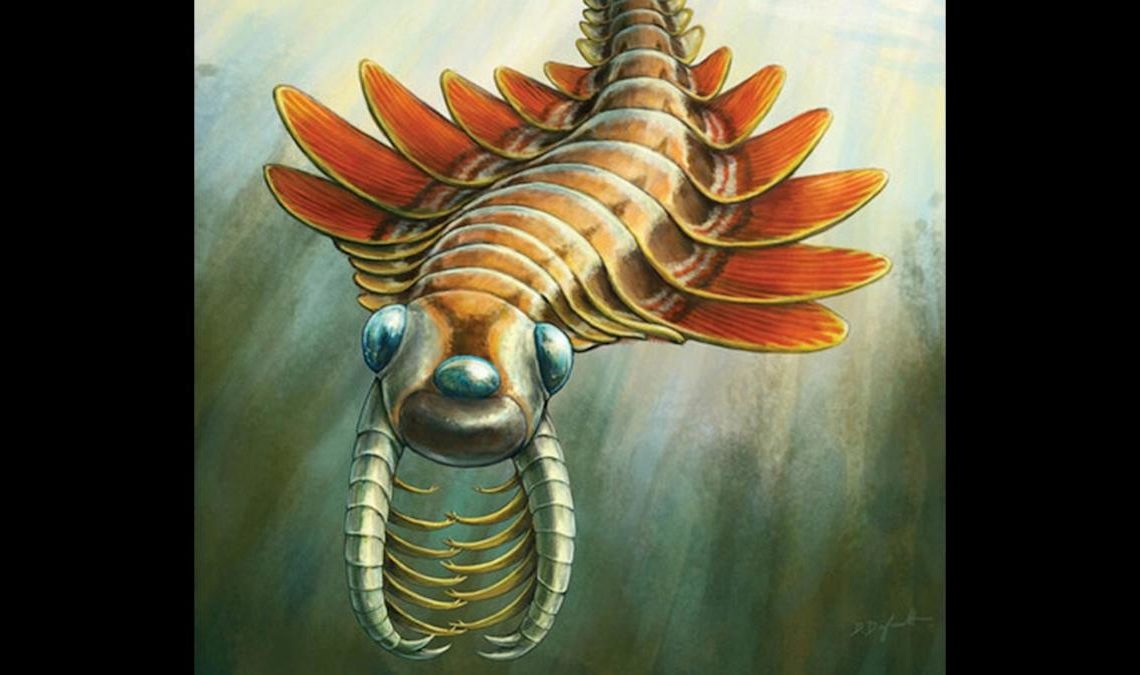Paleontologists have discovered that a three-eyed sea moth predator lived on Earth half a billion years ago with evidence found in one of the most fossil-rich areas of the world.
The fossils of Mosura fentoni — a species of arthropod that lived in the Cambrian Period — were discovered in Burgess Shale in the Canadian Rockies, a region known for its exceptional preservation of fossils, according to a paper published Wednesday in Royal Society Open Science.
The species belongs to a group of arthropods nicknamed “sea moths” that use a flap-like apparatus similar to wings to help them swim, the authors said in a statement. The mechanism gives the species a “vague appearance” to a moth and are distantly related to modern moths, spiders, crabs and millipedes.
MORE: Underwater camera captures elusive tentacled creature 3 miles below ocean surface
The 506 million-year-old fossil is an imprint of a creature that had three eyes, a jaw lined with teeth, sharp claws and abdominal segments lined with gills. However, the specimen is not a fish, the researchers said. It belongs to the radiodont group, an ancient line of sea predators that are now extinct.
“Radiodonts were the first group of arthropods to branch out in the evolutionary tree, so they provide key insight into ancestral traits for the entire group,” said Jean-Bernard Caron, curator of invertebrate paleontology at the Royal Ontario Museum, in a statement.
Several of the fossils are so clear that they show details of the specimen’s internal anatomy, including parts of the nervous and circulatory systems and digestive tract, Caron said, describing the details as “astounding.”
“Very few fossil sites in the world offer this level of insight into soft internal anatomy,” Caron said. “We can see traces representing bundles of nerves in the eyes that would have been involved in image processing, just like in living arthropods.”
MORE: What scientists learned from a well-preserved fossil of this iconic Jurassic-era species
The species had an open circulatory system that pumped blood into large internal body cavities called lacunae, which were preserved as reflective patches in the fossils.
The new species emphasizes that these early arthropods were already surprisingly diverse and were adapting in a comparable way to their distant modern relatives
Even more surprising than Mosura fentoni’s three eyes is a tail-like body made of segments lined with gills on its abdomen — something never before seen on a radiodont. The researchers compared its rear section to modern arthropods such as insects and horseshoe crabs.
“This is a neat example of evolutionary convergence with modern groups, like horseshoe crabs, woodlice, and insects, which share a batch of segments bearing respiratory organs at the rear of the body,” said Joe Moysiuk, curator of paleontology and geology at the Manitoba Museum and lead author of the study, in a statement.
MORE: Scientists discover ‘legless, headless wonder’ that predated the dinosaurs
The “intriguing” adaption may be the result of habitat preference of behavioral characteristics of the species that required more efficient respiration, the researchers said.
The Burgess Shale fossil sites, designated a UNESCO World Heritage Site in 1980, are located within the Yoho and Kootenay National Parks.
Dozens of Mosura fossils have been collected in Burgess Shale in recent decades, according to the paper.
What paleontologists learned from fossils of a 3-eyed predator that lived 500 million years ago originally appeared on abcnews.go.com
The post What paleontologists learned from fossils of a 3-eyed predator that lived 500 million years ago appeared first on ABC News.




